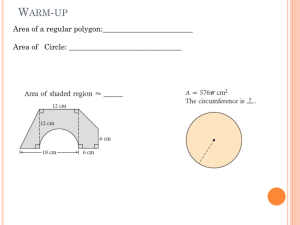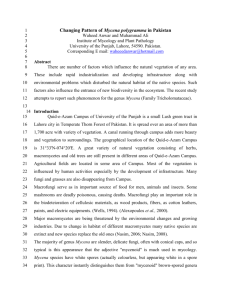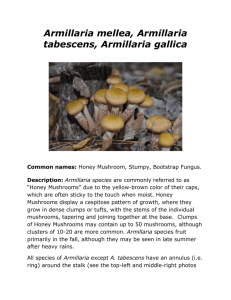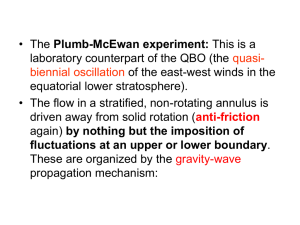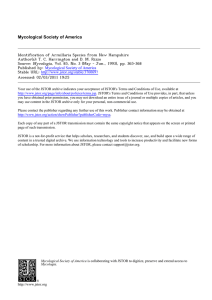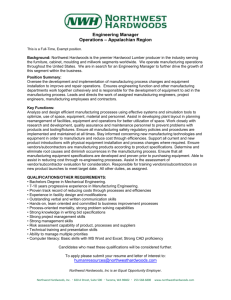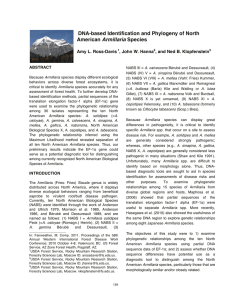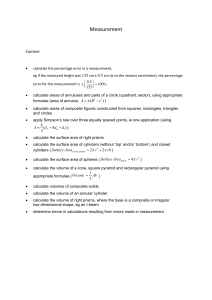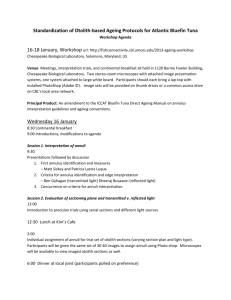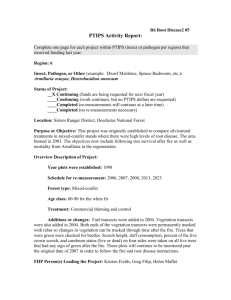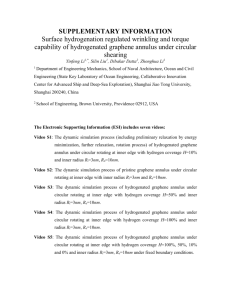ARMILLARIA in the Pacific Northwest
advertisement
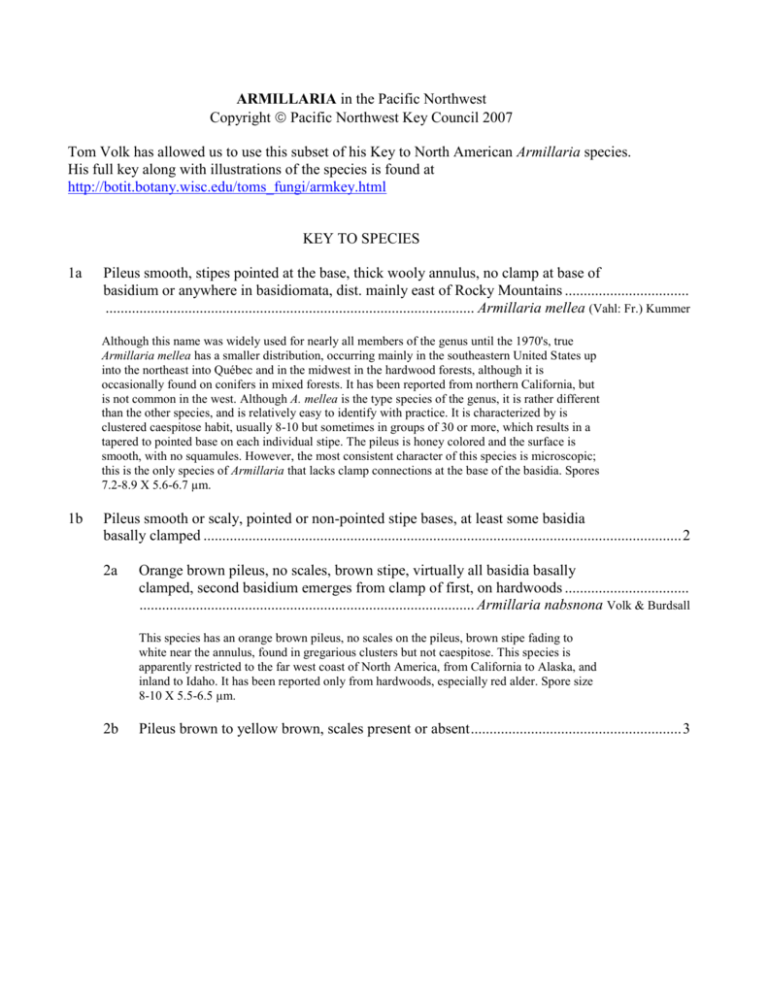
ARMILLARIA in the Pacific Northwest Copyright Pacific Northwest Key Council 2007 Tom Volk has allowed us to use this subset of his Key to North American Armillaria species. His full key along with illustrations of the species is found at http://botit.botany.wisc.edu/toms_fungi/armkey.html KEY TO SPECIES 1a Pileus smooth, stipes pointed at the base, thick wooly annulus, no clamp at base of basidium or anywhere in basidiomata, dist. mainly east of Rocky Mountains ................................. .................................................................................................. Armillaria mellea (Vahl: Fr.) Kummer Although this name was widely used for nearly all members of the genus until the 1970's, true Armillaria mellea has a smaller distribution, occurring mainly in the southeastern United States up into the northeast into Québec and in the midwest in the hardwood forests, although it is occasionally found on conifers in mixed forests. It has been reported from northern California, but is not common in the west. Although A. mellea is the type species of the genus, it is rather different than the other species, and is relatively easy to identify with practice. It is characterized by is clustered caespitose habit, usually 8-10 but sometimes in groups of 30 or more, which results in a tapered to pointed base on each individual stipe. The pileus is honey colored and the surface is smooth, with no squamules. However, the most consistent character of this species is microscopic; this is the only species of Armillaria that lacks clamp connections at the base of the basidia. Spores 7.2-8.9 X 5.6-6.7 µm. 1b Pileus smooth or scaly, pointed or non-pointed stipe bases, at least some basidia basally clamped ............................................................................................................................... 2 2a Orange brown pileus, no scales, brown stipe, virtually all basidia basally clamped, second basidium emerges from clamp of first, on hardwoods ................................. ......................................................................................... Armillaria nabsnona Volk & Burdsall This species has an orange brown pileus, no scales on the pileus, brown stipe fading to white near the annulus, found in gregarious clusters but not caespitose. This species is apparently restricted to the far west coast of North America, from California to Alaska, and inland to Idaho. It has been reported only from hardwoods, especially red alder. Spore size 8-10 X 5.5-6.5 µm. 2b Pileus brown to yellow brown, scales present or absent ........................................................ 3 3a Annulus thick, scales on pileus, basidiomata often clustered, with pointed stipe bases ...........................................................................................Armillaria ostoyae (Romagn.) Herink This species is mostly restricted to conifers and is a serious pathogen of many species in the northern conifer zone. It is also found in caespitose clusters, sometimes pointed at the bases of the individual stipes, with a brownish annulus. The pileus is brown colored, covered by dark scales, and can be very large, up to 1 foot in diameter, especially in the Pacific Northwest. This is the species that has been reported to cause some people some gastrointestinal upset if collected from hemlock, but we believe that most of the reported upset is due to undercooking (and overeating) of some of these larger collection. Spore size 8-11 X 5.5-7 µm. 3b Annulus cortinaceous (arachnoid, cobwebby), pileus not scaly (may have hairs), basidiomata clustered or single ....................................................................................................... 4 4a rare species in North America, apparently restricted to Washington and British Columbia, on hardwoods, often with deceptive double-appearing annulus (probably the same as Armillaria cepistipes Velen.) .................................. NABS XI NABS XI (North American Biological Species XI) of Morrison et al. 1998 has been found at four sites on the Olympic Peninsula of Washington (Banik, Volk, & Burdsall, 1996, Mycologia 88:492-496.) 4b 5a more widely distributed, annulus arachnoid, not appearing double ...................................... 5 some annulus cells greater than 8 µm diameter, on hardwoods in the East, on conifer in the West.............................................................. Armillaria sinapina Bérubé & Dessureault This species is similar in color to A. ostoyae, with similar, although somewhat smaller dark scales on the pileus. It normally occurs singly or sometimes in clusters of two or three. In the Northeast it can be found mainly on hardwoods and occasionally conifers, but in the Pacific Northwest (Idaho, Washington, Alaska, British Columbia) it seems to be more common on conifers, although it is often found on aspen there (K. Mallett, Pers. Comm.). In the Northeast, the major morphological character that distinguishes this species from the others is the "presence of a golden yellow universal veil that covers young fruiting bodies and later leaves remnants consisting of yellow warts or lumps of tissue on the cap, a yellow fibrous annulus, and many patches of fibers on the stipe" (Bérubé & Dessureault, 1988). However, we have not observed this yellow coloration on western specimens. Spore size 8.2-10 X 5.9-8 µm. 5b All cells of annulus less than 8 µm diameter, non pathogenic species, mostly east of the Rocky Mountains, rare in the west ........................ Armillaria gallica Marxmüller & Romagnesi This is by far the most widely distributed species east of the Rocky Mountains, including the northeast, midwest, and gulf coast, but is very rare in the west. It is almost always found on hardwoods, but occasionally on conifers. It can be distinguished by its solitary to gregarious habit, usually on soil, but occasionally "climbing" onto logs or stumps to fruit. The fruit bodies, which tend to be smaller than the other species, are directly attached to rhizomorphs (Darmono et al., 1992). The partial veil is cortinaceous, i.e. very similar to the cobwebby cortina of a Cortinarius species, leaving white "arachnoid" remnants on the stipe. The pileus is "tan to pinkish brown" and "distinctly hairy" ( Bérubé & Dessureault, 1988). The base is commonly swollen and sometimes stains yellow where bruised. Spore size 7.2-9.5 X 4.8-6 µm.
